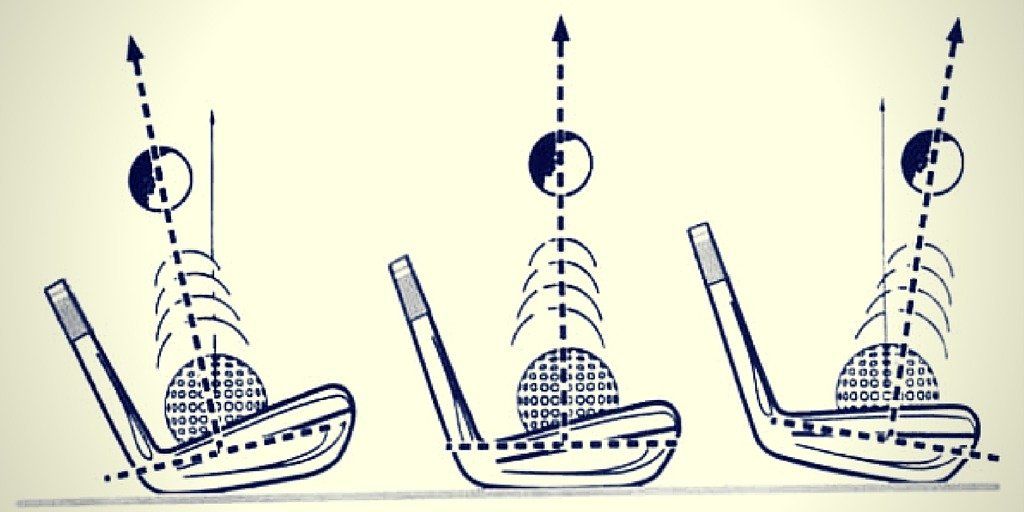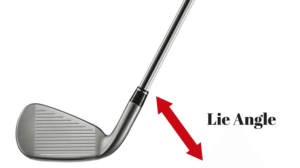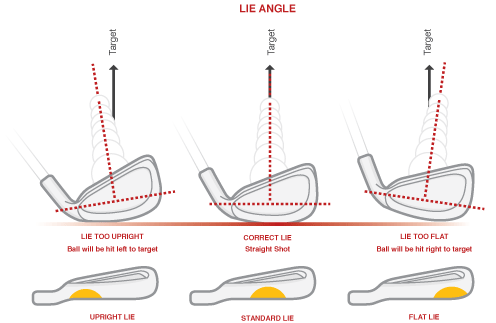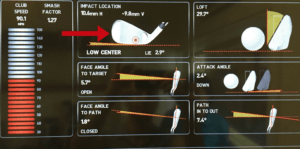
When golfers buy a new set of irons they don’t usually get any kind of adjustments made, most notably their lie angle. They incorrectly assume what they are buying is right for them.
Today I want to talk about one of the most important things players are overlooking when they purchase an iron set. If this specification is not adjusted properly for their particular swing, it could cause their shots to be traveling 8-10 yards offline from their intended target even if the player made a proper swing.
I am talking about lie angle.
Lie angle is one of the most important, if not THE most important thing to get right when you buy a set of irons. Each manufacturer has a different spec for the lie angle on their clubs, and a majority of golfers never get them adjusted for their particular swing.
What is lie angle?
Lie angle is defined as the angle between the shaft and the ground line when the club is measured in normal playing position with the center of the sole touching the ground line.

The most important thing about measuring lie angle for each particular golfer is how the club is interacting with the ground at impact. The angle of the club when you address the ball is not necessarily important.
There are only two scenarios that occur when your lie angle is not adjusted properly for your swing.
- The club is too upright, and the toe is not making contact with the ground at impact.
- The club is too flat, and the heel is not making contact with the ground at impact.
Take a look at this image to understand the ramifications of each scenario:

If your club is too upright at impact, then your shots will travel to the left of your target. Conversely, if your club is too flat, then your shots will be heading right.
For every degree that your lie angle is either too upright or flat, the ball will initially travel 4 yards off your intended target line. Some players have lie angles that are as much as 2-3 degrees off, which means they are making things very difficult for themselves on approach shots!
There is no standard
Showing up to the store and buying irons off the shelf without testing out the lie angle is a coin flip, because there is no standard for lie angle in the golf industry.
I went to the websites of some of the most popular manufactures and got the standard lie angles for 7-irons; here are the results:
Titlest AP1 – 63 degrees
Callaway XR – 62.5 degrees
Mizuno JPX-EZ – 61.5 degrees
Cobra King F6 – 62.5 degrees
Ping G25 – 62.25 degrees
As you can see, if you bought any of these irons you would be getting various lie angles, and there’s no guarantee any of them are the right ones for you.
How do you measure?
The traditional way to measure the lie angle of a golf club is to use an impact board and place tape on the sole of the club. This was always the basis of Ping’s color system. However, that method is coming into question and has been shown to not be as accurate for a number of reasons.
These days club fitters are using launch monitors to get a more accurate indication of what is going on at impact.
A few months ago I went for a fitting on a Foresight system, and learned that my current set of irons were way too upright for me. You can see in this image that the toe of my club was in the air at impact.

Since then I have corrected the issue with irons that are more flat, and it has straightened out my ball flight considerably. With that one simple fix I have more control over the golf ball.
Not everyone has access to these systems, and there is actually an easy way to measure if your lie angle is correct on your irons. All you need is a marker.
Draw a straight line on the back of the golf ball, and have it facing the clubhead. After you make impact the line will appear on the face.
If it’s pointing towards the toe, then your club is too upright. If it’s pointing towards the heel, then it’s too flat. If the line is perpendicular to the grooves on the face, then your lie angle is correct.

Wrapping it up
To briefly summarize, the lie angle of your irons is extremely important because it will greatly affect the initial direction of your shots. Not all irons are created equal, and most players are using irons that likely do not have the right specifications for their swing.
It’s relatively easy to get this fixed, as most clubs can be bent afterwards. Try this test out with the marker and see what kind of results you are getting with your current set of irons.
Having an incorrect lie angle adjusted can make a world of difference in your approach shots.
We care about the protection of your data Read our Privacy Policy